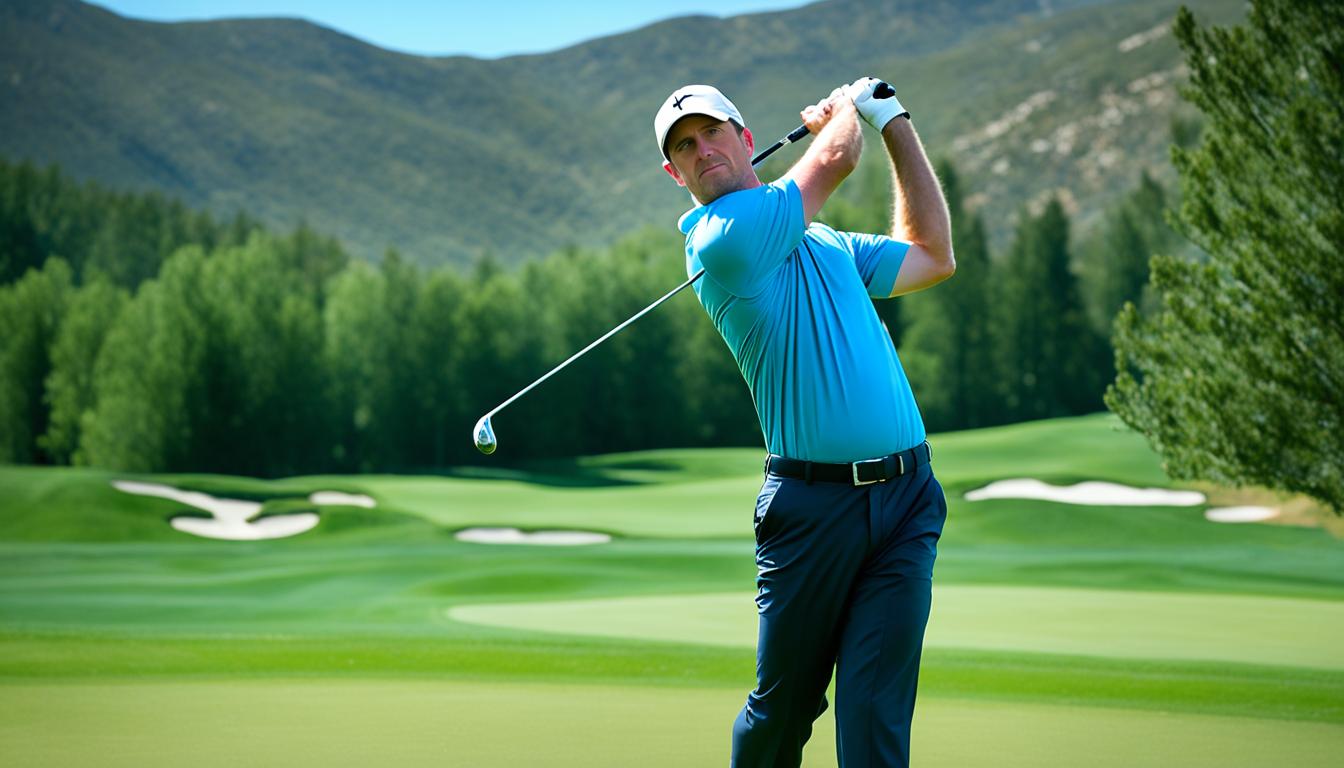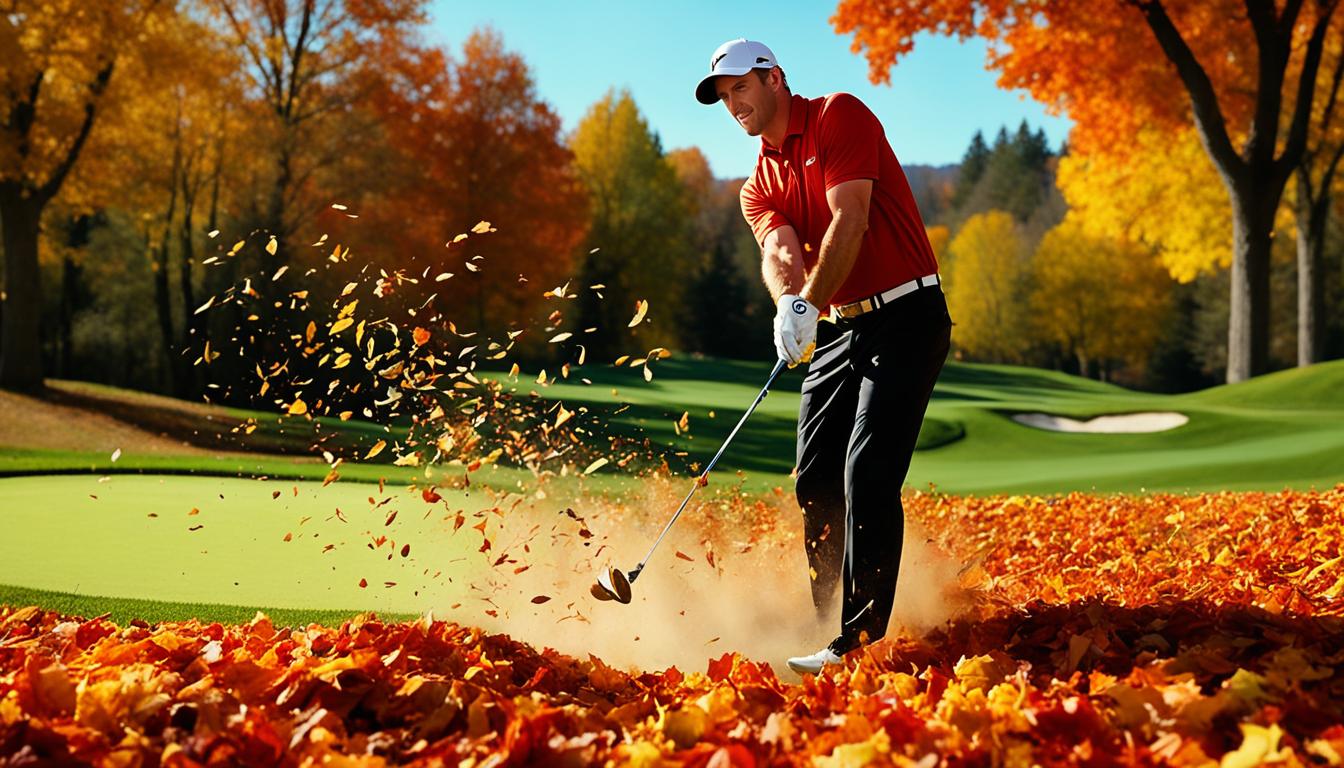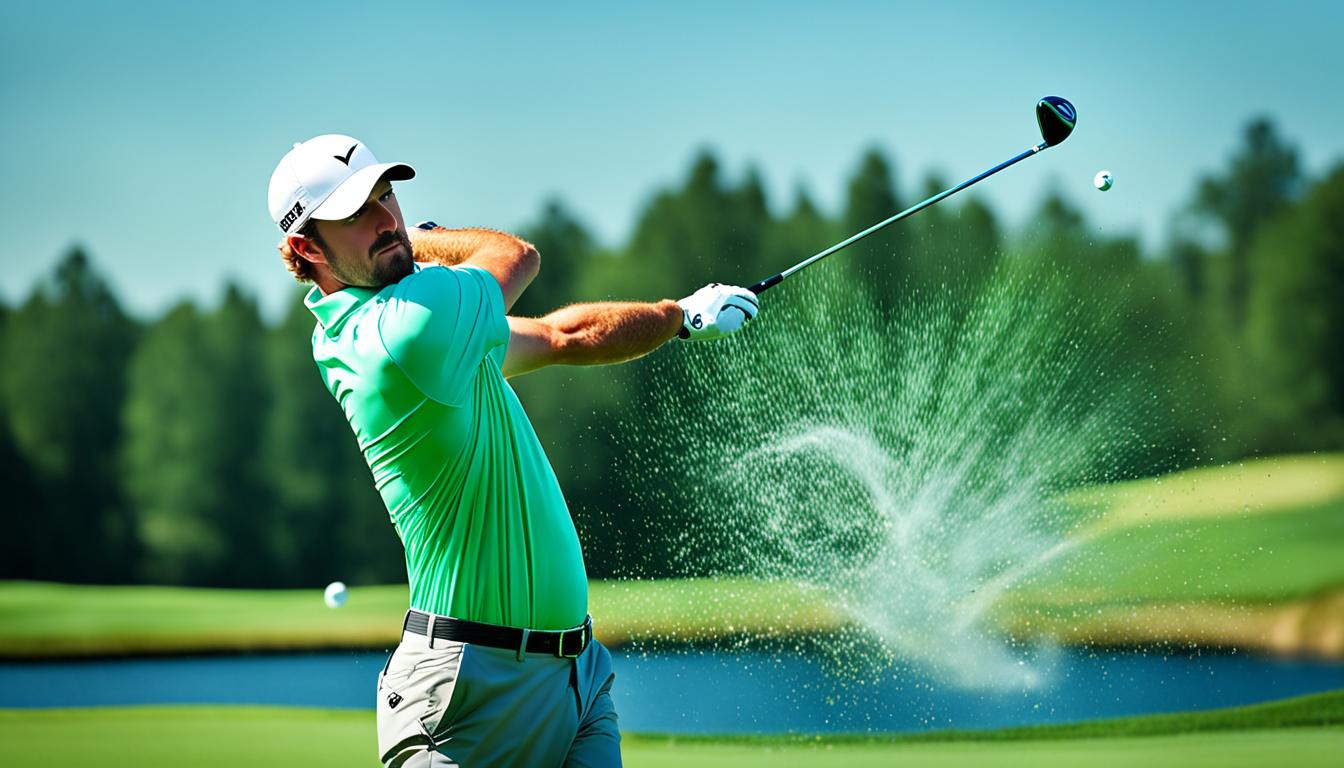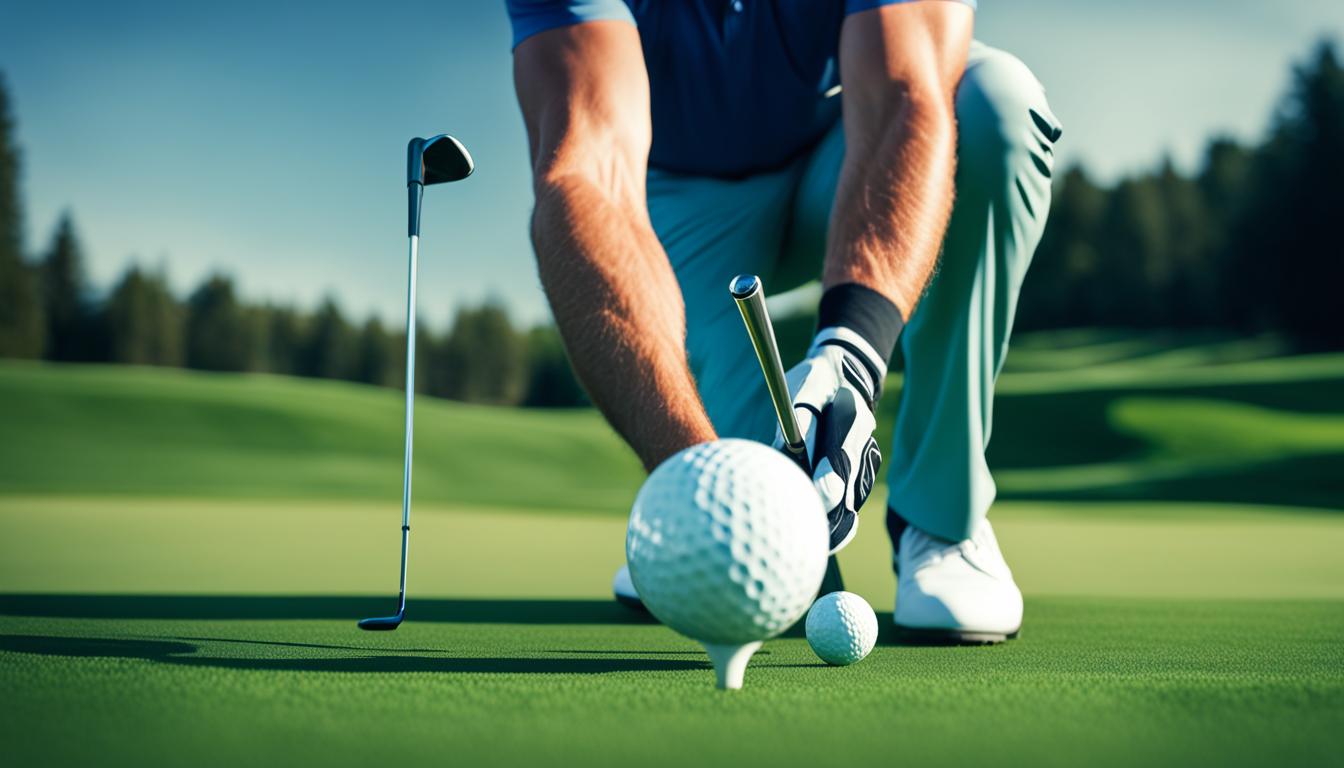Slicing in golf is a common problem that many golfers face. It refers to a shot that curves in the air from left to right (for right-handed golfers) or right to left (for left-handed golfers). The main causes of a golf slice are an open clubface at impact and an out-to-in swing path. These factors create sidespin on the ball, causing it to curve off the intended target line. In this guide, we will explore the common causes of a golf slice and provide effective strategies for correction.
Key Takeaways:
- Understanding what a golf slice is and why it happens is crucial for fixing it.
- Grip issues, stance and posture, clubface angle, swing path, and equipment considerations are common causes of a golf slice.
- Correcting a golf slice involves making adjustments to grip, stance, backswing and downswing, and clubface control.
- Consistent practice, use of training aids, and mental focus are key in improving your golf game and reducing slices.
- Fixing a golf slice is a process that takes time, patience, and dedication to continuous improvement.
Understanding the Golf Slice
To fix a golf slice, it is crucial to have a clear understanding of what it is and why it happens. A golf slice is a shot that curves in the air from left to right (for right-handed golfers). It occurs when the clubface is open at impact and the swing path is out-to-in. The combination of an open clubface and an out-to-in swing path creates sidespin on the ball, causing it to curve off line. Understanding the mechanics behind a golf slice is the first step towards correcting it.
When you slice the ball, it can be frustrating to see it veer off course. By understanding the causes of a golf slice, you can work on making the necessary adjustments to your swing. Let’s take a closer look at the two main factors that contribute to a golf slice:
- Open Clubface at Impact: The clubface plays a critical role in determining the direction of the ball. If the clubface is open at impact, meaning it is pointing to the right of the target for right-handed golfers, it will cause the ball to spin and curve to the right.
- Out-to-In Swing Path: The swing path refers to the direction the clubhead is moving during impact. An out-to-in swing path occurs when the clubhead approaches the ball from outside the target line and then crosses over it during impact. This swing path creates sidespin, which leads to the ball curving from left to right.
Now that we have a better understanding of the golf slice and its causes, we can move on to exploring the common factors that contribute to this issue. In the next section, we will delve into the grip, stance, clubface angle, swing path, and equipment considerations that can lead to a golf slice.
Common Causes of a Golf Slice
When it comes to the frustrating issue of a golf slice, there are several common causes to consider. Addressing these factors can significantly improve your golf game and help you hit straighter and more accurate shots.
Grip Issues
A proper grip is crucial in preventing a slice. Some golfers may have an improper grip or a grip that is too weak, leading to an open clubface at impact. To rectify this, ensure your grip is correct and firm, providing more control over the clubface.
Stance and Posture
Poor stance and posture can contribute to an out-to-in swing path, resulting in a slice. To avoid this, maintain a balanced and athletic posture with your feet, hips, and shoulders aligned towards the target. This will promote a more fluid and accurate swing.
Clubface Angle
The position of the clubface at impact is a crucial determinant of a golf slice. An open clubface at impact promotes sidespin on the ball, causing it to veer off course. Focus on keeping the clubface square to the target line to minimize slicing.
Swing Path
The swing path plays a significant role in clubface alignment and can contribute to a slice. An out-to-in swing path increases the likelihood of an open clubface, resulting in a left-to-right ball flight for right-handed golfers. Strive to swing along an inside-out path, promoting a square clubface at impact.
Equipment Considerations
The wrong equipment can also exacerbate slicing issues. Using a driver with too little loft, for example, can lead to an increased side spin on the ball. Evaluate your equipment and ensure that it suits your swing style and minimizes slicing tendencies.
| Common Causes of a Golf Slice | Potential Solutions |
|---|---|
| Grip issues | Proper grip technique and firmness |
| Stance and posture | Balanced and aligned posture |
| Clubface angle | Keep the clubface square to the target line |
| Swing path | Ensure an inside-out swing path |
| Equipment considerations | Evaluate and select suitable equipment |
By identifying and addressing these common causes of a golf slice, you can significantly improve your swing mechanics and minimize slicing tendencies. In the next section, we will explore effective strategies for correcting your golf slice.

Correcting Your Golf Slice
Fixing a golf slice requires making adjustments to various aspects of your swing. When it comes to correcting your golf slice, addressing issues with your grip, stance, posture, backswing and downswing, clubface control, and incorporating drills and exercises into your practice routine can all contribute to improving your swing mechanics and reducing slices.
Adjust Your Grip
One of the first areas to focus on when correcting your golf slice is your grip. Ensure that your grip is in a more neutral position, neither too weak nor too strong. A proper grip helps ensure that the clubface is square at impact, reducing the tendency for the ball to slice.
Pay Attention to Stance and Posture
Proper stance and posture are crucial elements in fixing a golf slice. Align your feet, hips, and shoulders towards the target to promote a more on-plane swing path. Maintaining a balanced and athletic posture throughout your swing can help prevent an out-to-in path, which contributes to slicing.
Focus on Backswing and Downswing Mechanics
Paying attention to your backswing and downswing is vital for correcting a golf slice. Ensure a smooth transition and maintain a consistent swing plane. Avoid swinging too much from the outside to the inside, as this can cause the clubface to open at impact. A more controlled and balanced backswing and downswing can help produce straighter shots.
Develop Clubface Control
Clubface control is critical in reducing slices. Practice controlling the clubface through impact, aiming to keep it square to your target line. Pay attention to the position of the clubface at impact and focus on maintaining a neutral clubface throughout your swing.
Incorporate Drills and Exercises
Incorporating drills and exercises into your practice routine can reinforce the correct swing mechanics needed to fix a golf slice. Work on exercises that promote proper body rotation, wrist hinge, and a consistent swing path. Practice drills that specifically target clubface control and reducing slices.
| Correcting Your Golf Slice | Key Points |
|---|---|
| Adjust Your Grip | – Ensure a neutral grip position |
| Pay Attention to Stance and Posture | – Align feet, hips, and shoulders towards the target – Maintain balanced and athletic posture |
| Focus on Backswing and Downswing Mechanics | – Maintain a consistent swing plane – Avoid an out-to-in swing path |
| Develop Clubface Control | – Keep the clubface square to the target line – Maintain neutral clubface position |
| Incorporate Drills and Exercises | – Practice body rotation and wrist hinge – Target clubface control and reducing slices |
Practicing Your New Swing
Once you have made corrections to your swing, consistent practice is key to solidifying the changes. Set aside dedicated time for practice sessions, focusing on repetition and consistency.
“Practicing your new swing is the key to mastering it. Consistency in practice will help you internalize the correct mechanics and build muscle memory.”
Utilize golf swing trainers, divot boards, and golf impact bags to reinforce the new swing mechanics. These training aids can provide immediate feedback and help you develop a more consistent swing. Use them to fine-tune your technique and improve your ball-striking skills.
When practicing, don’t limit yourself to a single club or distance. Vary the clubs you use and the distances you practice at. This will help you apply the corrected swing to different situations on the golf course. By practicing with different clubs and distances, you’ll gain a better understanding of how the changes in your swing affect ball flight and distance.
Practice Routine Example
| Session | Focus | Activities |
|---|---|---|
| 1 | Alignment and Setup | Work on proper grip, stance, and posture. Use a training aid to reinforce correct alignment. |
| 2 | Backswing and Downswing | Focus on a smooth and controlled backswing and downswing. Use drills to develop a consistent tempo. |
| 3 | Clubface Control | Practice controlling the clubface at impact. Use alignment sticks or training devices to improve square contact. |
| 4 | Shot Selection | Practice hitting shots with different clubs and distances. Experiment with shot shaping and trajectory. |
Consider recording your practice sessions for video analysis to track your progress. This allows you to visually assess your swing and identify areas for improvement. Compare your current swing to the corrected swing and look for any inconsistencies or lingering issues.
During practice, it’s essential to maintain mental focus. Visualize hitting straight, accurate shots with your corrected swing. Avoid distractions and stay present in the moment. Developing a strong mental game will help translate your practice improvements to the golf course.
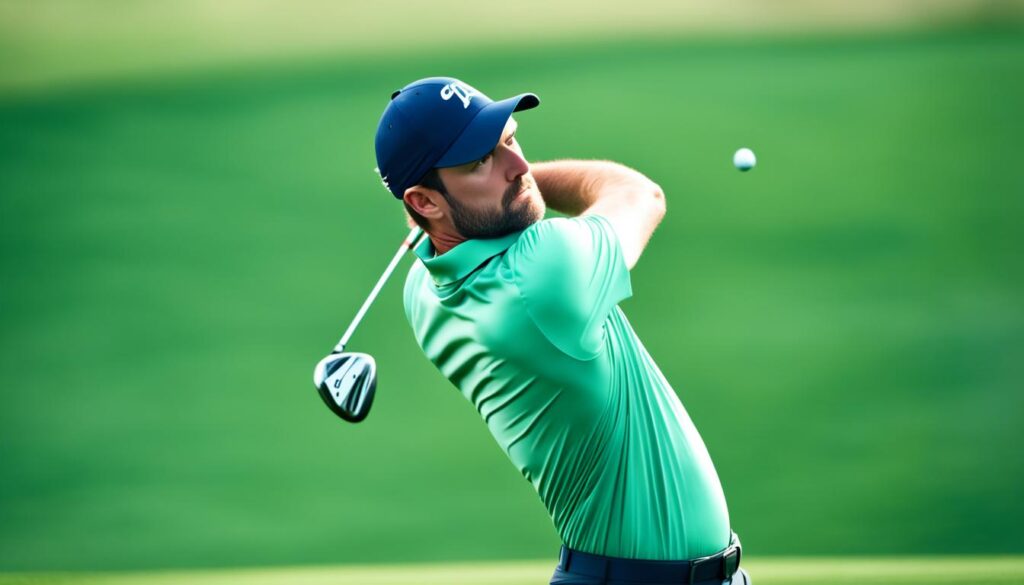
By following a structured practice routine and incorporating training aids, varied distances and clubs, video analysis, and maintaining mental focus, you can reinforce your new swing and improve your overall golf game.
Conclusion
Fixing a golf slice is a process that requires time, patience, and consistent practice. By understanding the causes of a slice and making necessary adjustments to your grip, stance, swing path, and clubface control, you can improve your golf game and reduce slicing issues. Consistency is key in implementing these changes and reinforcing the corrected swing mechanics.
Using training aids can greatly assist in honing your skills and reinforcing the new swing mechanics. Tools like golf swing trainers, divot boards, and golf impact bags can provide valuable feedback and help you develop a more controlled and balanced swing. Additionally, practicing with varied distances and clubs will allow you to apply the corrected swing to different situations, enhancing your overall game.
Video analysis can be a powerful tool in tracking your progress and identifying areas for improvement. By recording your practice sessions and analyzing the footage, you can gain valuable insights into your swing and make necessary adjustments. It is important to maintain mental focus during practice sessions and visualize hitting straight, accurate shots with the corrected swing.
Remember, golf is a game of continuous improvement. The journey to fixing a golf slice is as rewarding as the destination. Embrace the process, stay dedicated to practicing and implementing the necessary adjustments, and watch as your golf game improves. With persistence, you can conquer your golf slice and enjoy a more consistent and rewarding golfing experience.
FAQ
What is a golf slice?
A golf slice refers to a shot that curves in the air from left to right (for right-handed golfers) or right to left (for left-handed golfers).
What causes a golf slice?
The main causes of a golf slice are an open clubface at impact and an out-to-in swing path.
What are some common causes of a golf slice?
Common causes of a golf slice include grip issues, poor stance and posture, clubface angle, swing path, and equipment considerations.
How can I fix my golf slice?
To fix a golf slice, you can make grip adjustments, improve your stance and posture, pay attention to your backswing and downswing, and develop clubface control through drills and exercises.
How can I practice my new swing to fix my golf slice?
Consistent practice, use of training aids, practicing with varied distances and clubs, video analysis, and maintaining mental focus can help you practice your new swing and fix your golf slice.
What is the key to fixing a golf slice?
Fixing a golf slice requires time, patience, and practice. By understanding the causes of a slice and making necessary adjustments to your swing mechanics, you can improve your golf game and reduce slices.
